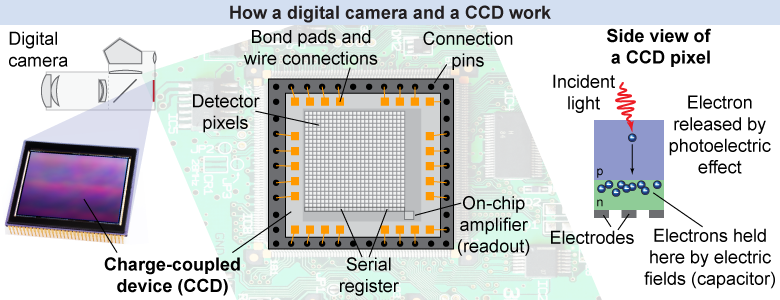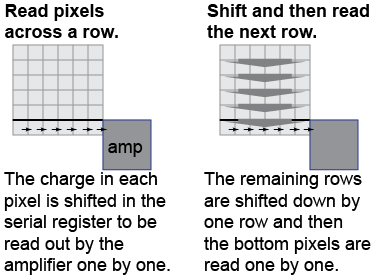|
The invention of photographic emulsion in the 1850s revolutionized how we document history and society. The invention of the charge-coupled device (CCD) by Willard Boyle and George Smith in 1969 led to many advances in astronomy and other fields. Digital cameras based on CCDs have made photography easy to do and ubiquitous in society. How does a digital camera work? 
|

|
The light detector in a digital camera is the CCD. A detector is an instrument used to detect and measure radiation. Photons of visible light enter the camera and strike the silicon surface of the CCD, liberating electrons through the photoelectric effect. A CCD typically has millions of tiny pixels, each of which acts as both a detector and a storage bin. Each pixel is a p-n junction semiconductor device, which acts very similar to photovoltaic cells used in solar arrays. In a CCD, each pixel acts as a capacitor, where electric fields keep the electrons in place until it is time to read out the picture. 
|
 The accumulated charge in a pixel corresponds to the number of photons that were incident upon the pixel and liberated an electron. An amplifier converts the charge of the stored electrons into a voltage that is read and stored. If more photons strike a pixel, then it stores more electrons and results in a higher voltage when the pixel is read out. The CCD shifts the charge for the first row’s pixels one by one across the serial register to the amplifier where the voltage is read out. The CCD then shifts the remaining pixels down by a row and reads out the second row’s pixels one by one. In this way the CCD creates an image of the number of photons detected in each pixel.
The accumulated charge in a pixel corresponds to the number of photons that were incident upon the pixel and liberated an electron. An amplifier converts the charge of the stored electrons into a voltage that is read and stored. If more photons strike a pixel, then it stores more electrons and results in a higher voltage when the pixel is read out. The CCD shifts the charge for the first row’s pixels one by one across the serial register to the amplifier where the voltage is read out. The CCD then shifts the remaining pixels down by a row and reads out the second row’s pixels one by one. In this way the CCD creates an image of the number of photons detected in each pixel. 
 |
There are two main technologies that are used today in digital cameras. The charge-coupled device has been used since the early 1970s, while cameras using active-pixel sensors (APS) date to the mid-1990s. APS imagers are based on complementary metal oxide semiconductor (CMOS) sensors. Both CCD and APS imagers use silicon to detect photons and store the electrons in the pixel, but they differ in how the electrons are read out to create an image. The CCD uses between one and four read-out amplifiers, so all the pixels must be shifted across the device to reach the corner with the analog-to-digital converter. The APS imager instead has tiny transistors right next to each pixel that read out just that pixel's electrons. A CCD camera is significantly more sensitive, so it is used more for scientific applications. A CMOS sensor uses much less power, so it is commonly used for mobile camera phones. 
|
To create a color image with a CCD, alternating pixels have a red, green, or blue filter mounted in front of them, called a Bayer mask. In the digital image, adjacent RGB pixels are combined to create a color that you can see on a computer screen. 
|
What are the relative strengths of CCD and APS imager (CMOS) technology for a detector in a digital camera?
 |
CCD technology has been around longer than CMOS technology, so CCD technology is more mature. A CCD is more sensitive, so it produces a higher quality image. A CMOS sensor uses much less power, so it can be used more easily in a mobile device. 
|

